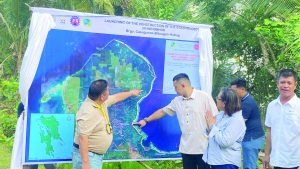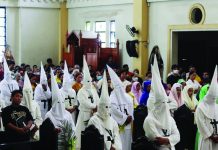Part of a circumferential road project

HOMONHON ISLAND, GUIUAN, Eastern Samar– Construction of the 21-kilometer road that will connect three villages of this historic island will soon start after the launching of the road project was held on Saturday (March 16) in Barangay Bitaugan.
The launching was led by 4Ps party-list Representative and House Minority Floor Leader Marcelino Libanan, Guiuan Mayor Annaliza Gonzales-Kwan, and Eastern Samar board member RV Evardone.
The project with a total length of 21 kilometers costs P105 million funded by the national government under the 2024 General Appropriations Act and is part of the planned Homonhon Island Circumferential road that has a total length of 61 kms.
“This is just the start of the road projects that we will implement here in Homonhon and this is my commitment to complete the project that will connect villages on this island,” Rep.Libanan said in his message during the launching of the road project in Bitaugan.
Libanan promised to also look for funds for the construction of the road leading to Brgy. Inapulangan, the only village of the town that remains without road access.
Mayor Gonzales-Kwan said that this road project will not only help provide easier access for residents and their farm products and during times of emergencies but will also help tourists reach the village faster to visit the famous Handig beach that is located in Brgy. Habag.
“This road project will ensure residents better services from the government even they are residing in isolated areas,” she said.
“Once completed, this will bring progress and development to the village,” Kwan added.
But while this road project will bring development, some residents from Habag expressed apprehension that this may also result in mining companies finally reach their villages and conduct mining operations.
Homonhon Island is known for its contribution not only to the pages of Philippines history but also to the world, particularly in navigation for being part of the first circumnavigation of the world after the crew of Ferdinand Magellan landed in the area on March 17, 1521, while looking for a new route to Spice Island or Moluccas.
Four mining companies are operating on the island particularly in the villages of Cagusuan and Casuguran, extracting nickel and chromite. However, their operations are limited to these two villages because they are also using Canawayaun, Pagbabangnan, and Culasi as their access road.
“We are not anti-development. We will favor mining operations for as long as this will not destroy our environment,” Habag village chairwoman Jessica Baguinon.
“Our apprehension right now is if this road is completed this might result in mining companies entering our village,” the village chief added.
But now that the access road going to their place is being improved, there is now a possibility that part of their village will also be mined out, Baguinon said.
“This will greatly affect our farmers and fisherfolks,” she said.
Most of the 317 residents of Habag rely on lime and root crops planting, and fishing.
Baguinon added that although they are the most visited village in Homonhon by tourists, this is not enough to provide the residents enough income for the sustenance of their daily needs because tourists would usually visit them during the summer season.
During the launching of the Habag-Bitaugan road project, Mayor Kwan announced that the municipal government is preparing a comprehensive development master plan for Homonhon wherein it aims to address the needs of every villages on the island.
When asked for their reaction on the announcement of the town mayor, the village chief and other officials in Bitaugan replied that this has to be seen first before they believe and give their support.
The launching of the road project from Bitaugan to Hapag was part of the activities organized by the municipal government for the 503rd Philippine commemoration of the first circumnavigation of the world.
It was on March 16, 1521 when the fleet of Magellan saw the mainland of Samar Island but failed to anchor due to rough sea conditions, the following day they sailed toward Suluan Island but after seeing that people were inhabiting the island and out of fear that they will be attacked like on what happened to them in Guam, they remained in their ship and sailed toward Homonhon Island.
It was on March 17, 1521 when they docked and set foot on Homonhon Island to attend to their sickly crew members and look for food and other provisions that they could use in their journey.
(ROEL T. AMAZONA/LIZBETH ANN A. ABELLA)



